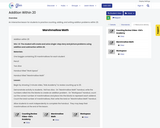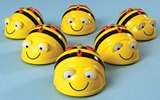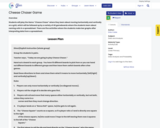
An interactive lesson for students to practice counting, adding, and writing additon problems within 20.
- Subject:
- Number and Number Sense
- Material Type:
- Activity/Lab
- Author:
- Sherry Wall
- Date Added:
- 07/24/2020

Resources to support the Mathematics Standards of Learning for Lower Primary grades

An interactive lesson for students to practice counting, adding, and writing additon problems within 20.

This is a remix of Alike or Different Game from Illustrative Mathematics, https://tasks.illustrativemathematics.org/content-standards/tasks/515. The purpose of this activity is to give students practice classifying objects according to one attribute to support sol K.12. The teacher gives each student an object. They travel the room with their hand raised to find another student to compare their object with. They compare to see if the object is alike or different and how (color, size, shape, thickness). They trade objects and travel the room to find someone else to compare with.

This video is part of the Learn and Grow with WHRO TV series. Watch Kelsey Eanes teach about shapes.

This video is part of the Learn and Grow with WHRO TV series. Watch Carolyn Harris teach about sorting shapes according to one or two attributes.

Students will categorize attribute blocks based on their color, thickness and/or size. Optionally, connections to categorizing will be related to robots (e.g. looks, motions, sounds) and coding.

ClassifyingMathematics Instructional Plans (MIPs) help teachers align instruction with the 2016 Mathematics Standards of Learning (SOL) by providing examples of how the knowledge, skills and processes found in the SOL and curriculum framework can be presented to students in the classroom.

Recognizing and describing part-whole relationships for numbers up to 10Mathematics Instructional Plans (MIPs) help teachers align instruction with the 2016 Mathematics Standards of Learning (SOL) by providing examples of how the knowledge, skills and processes found in the SOL and curriculum framework can be presented to students in the classroom.

Composing and Decomposing Numbers to 10 .Mathematics Instructional Plans (MIPs) help teachers align instruction with the 2016 Mathematics Standards of Learning (SOL) by providing examples of how the knowledge, skills and processes found in the SOL and curriculum framework can be presented to students in the classroom.

Create a Beebot Mat for students to practice SOL k.7 The student will recognize the attributes of a penny, nickel, dime, and quarter and identify the number of pennies equivalent to a nickel, a dime, and a quarter.

Students determine if a design solution works as intended to change the speed or direction of an object with a push or pull by designing and creating a ramp. They test their design, make improvements and redesign their ramp before retesting. They graph their data to determine which ramp makes their ball hit their intended target.

Comparing two sets using the words more, fewer, and sameMathematics Instructional Plans (MIPs) help teachers align instruction with the 2016 Mathematics Standards of Learning (SOL) by providing examples of how the knowledge, skills and processes found in the SOL and curriculum framework can be presented to students in the classroom.

Students will use the base ten blocks to build the number given. Teachers may use this to introduce, model, as guided practice or as an independent activity for students to show what they know.

Identifying ordinal positions first through tenth, using ordered sets of 10 concrete objects Mathematics Instructional Plans (MIPs) help teachers align instruction with the 2016 Mathematics Standards of Learning (SOL) by providing examples of how the knowledge, skills and processes found in the SOL and curriculum framework can be presented to students in the classroom.

Butterfly adaptations are linked to Greek and Roman mosaics.

Calendar languageMathematics Instructional Plans (MIPs) help teachers align instruction with the 2016 Mathematics Standards of Learning (SOL) by providing examples of how the knowledge, skills and processes found in the SOL and curriculum framework can be presented to students in the classroom.

Identifying the components of a calendar, including days, weeks and monthsMathematics Instructional Plans (MIPs) help teachers align instruction with the 2016 Mathematics Standards of Learning (SOL) by providing examples of how the knowledge, skills and processes found in the SOL and curriculum framework can be presented to students in the classroom.

Telling and writing time to the nearest five minutesMathematics Instructional Plans (MIPs) help teachers align instruction with the 2016 Mathematics Standards of Learning (SOL) by providing examples of how the knowledge, skills and processes found in the SOL and curriculum framework can be presented to students in the classroom.

Students will play the Game “Cheese Chase” where they learn about moving horizontally and vertically on a grid, which will be followed up by a variety of 40 gameboards where the students learn about naming cells in a spreadsheet. There are five activities where the students make bar graphs after interpreting data from a spreadsheet.

Identifying the 10-to-one relationship among ones, tens, and hundreds, using manipulativesMathematics Instructional Plans (MIPs) help teachers align instruction with the 2016 Mathematics Standards of Learning (SOL) by providing examples of how the knowledge, skills and processes found in the SOL and curriculum framework can be presented to students in the classroom.

This lesson is part of the Virginia K-12 Computer Science Pipeline which is partly funded through a GO Virginia grant in partnership with Chesapeake Public Schools, Loudoun County Public Schools, and the Loudoun Education Foundation. During this lesson, students will program a Bee-Bot (or similar robot) to locate fraction models.